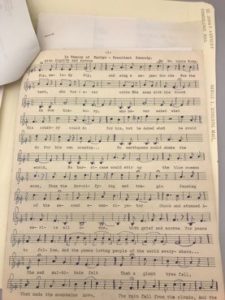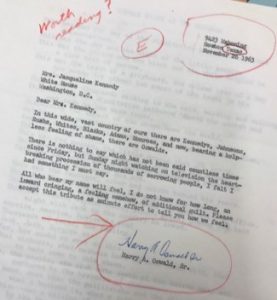SLIS Alternative Spring Break at the John F. Kennedy Presidential Library and Museum
By Lori Eaton, MLIS Student
A Collection Created by the People
 Dip your hand into a box of condolence mail held in the archives at the John F. Kennedy Presidential Library and Museum and you'll see grief expressed in many forms. Perhaps it was President Kennedy's youth or the violent and very public way he died that triggered the outpouring of mail. Through the National Archives and Records Administration Alternate Spring Break program, I was honored to spend a week sorting, alphabetizing, foldering, and boxing some of the thousands of pieces of mail that represent the sorrow of a nation at a particular moment in our history.
Dip your hand into a box of condolence mail held in the archives at the John F. Kennedy Presidential Library and Museum and you'll see grief expressed in many forms. Perhaps it was President Kennedy's youth or the violent and very public way he died that triggered the outpouring of mail. Through the National Archives and Records Administration Alternate Spring Break program, I was honored to spend a week sorting, alphabetizing, foldering, and boxing some of the thousands of pieces of mail that represent the sorrow of a nation at a particular moment in our history.
People were moved to pay tribute in whatever way they could. Local and state governments made resolutions, renamed streets and schools, and gathered contributions for the memorial fund that would eventually support the presidential library where their own letters are now held. People sent poems, songs, drawings, mass cards, even sticks of gum. Letters came with photos attached - school portraits, pictures of local memorial services, and even photos of the sender's television broadcasting the funeral procession.
Though letters from world leaders (Winston Churchill) and public figures (Vivian Leigh and Bing Crosby) are impressive to view, it is the personal way ordinary Americans offered condolences that I found most poignant. There was a letter from a young American serviceman stationed in Germany who witnessed the tragedy through the eyes of another nation. He wrote about attending a memorial gathering where people held signs that read, "Ich bin ein Berliner" referencing President Kennedy's historic speech in that city in June 1963. Another letter, from someone with the last name Oswald, expressed how he felt "an inward cringing, a feeling somehow, of additional guilt" at the name he shared with the man accused of killing the president.
 The most frequent requests for access to the Condolence Mail Collection has been from people asking about a letter they or someone they knew sent to the Kennedy family. The way the collection was originally processed made it virtually impossible to locate an individual letter based on the name of the sender. In 2015, the archives staff made it a priority to reprocess the collection and make it more accessible to the public. By the time Alternate Spring Break 2017 concluded, the interns and staff had completed processing for all Series 1, Domestic Condolence Mail through the letter P. Jenny Marciello, the project archivist, hopes that by the end of 2017 both Series 1 and Series 2, Foreign Condolence Mail will be more readily accessible to researchers.
The most frequent requests for access to the Condolence Mail Collection has been from people asking about a letter they or someone they knew sent to the Kennedy family. The way the collection was originally processed made it virtually impossible to locate an individual letter based on the name of the sender. In 2015, the archives staff made it a priority to reprocess the collection and make it more accessible to the public. By the time Alternate Spring Break 2017 concluded, the interns and staff had completed processing for all Series 1, Domestic Condolence Mail through the letter P. Jenny Marciello, the project archivist, hopes that by the end of 2017 both Series 1 and Series 2, Foreign Condolence Mail will be more readily accessible to researchers.
The condolence collection contains the best and worst of us as citizens. It documents the mood and concerns of a nation in a time of fear and upheaval. It is not a collection of papers created by one president or even one administration. It is a collection created by the people, as in "We, the People of the United States of America." I am proud to have played a small part in returning it to them.